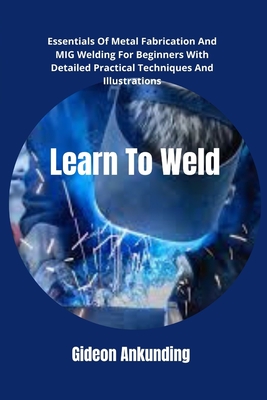You are here
Back to topLearn To Weld: Essentials Of Metal Fabrication And MIG Welding For Beginners With Detailed Practical Techniques And Illustrations (Paperback)
$15.00
Usually Ships in 1-5 Days
Description
Welding is a widely used process in manufacturing, construction, and various other industries. It involves joining two or more pieces of metal together by melting the materials at the joint and allowing them to cool, thereby creating a strong and permanent bond. Welding is a fundamental skill that has revolutionized the way structures and products are built.
The process of welding involves several key elements, including a heat source, a filler material (in some cases), and protective measures. The most common heat sources used in welding are electric arcs, flames, lasers, or even friction. The choice of heat source depends on the specific application and the materials being welded.
During the welding process, intense heat is generated, causing the materials to melt and fuse together. This fusion creates a metallurgical bond between the pieces, resulting in a joint that is as strong or sometimes even stronger than the original materials. The use of a filler material, such as a welding rod or wire, may be necessary to provide additional strength and fill any gaps between the pieces being joined.
Welding also requires careful consideration of safety precautions. The high temperatures and intense light emitted during welding can pose risks to the welder's eyes and skin. Therefore, protective gear, such as welding helmets, gloves, and clothing, is essential to ensure personal safety.
There are various welding techniques available, each suited for different applications and materials. Some common welding methods include:
Shielded Metal Arc Welding (SMAW): Also known as stick welding, SMAW uses a consumable electrode coated in flux. The electrode melts and forms a protective gas shield around the weld, preventing contamination.
Gas Metal Arc Welding (GMAW): Also known as MIG/MAG welding, GMAW uses a continuously fed wire electrode and a shielding gas. The wire melts and forms the weld, while the gas shield protects the molten metal from the atmosphere.
Tungsten Inert Gas Welding (TIG): TIG welding uses a non-consumable tungsten electrode to produce the arc and a separate filler material if needed. An inert gas, such as argon, is used to shield the weld from the surrounding air.
Flux-Cored Arc Welding (FCAW): FCAW is similar to GMAW, but it uses a tubular electrode filled with flux. The flux produces a shielding gas when heated, eliminating the need for an external shielding gas.
These are just a few examples of welding techniques, and there are many others, each with its own advantages and applications.
Welding plays a crucial role in numerous industries, including construction, automotive, aerospace, shipbuilding, and manufacturing. It enables the fabrication of complex structures and components, ensuring strength, durability, and reliability.
Mastering welding techniques requires training, practice, and an understanding of different materials and their properties. Skilled welders are in high demand and can pursue various career paths, ranging from construction and fabrication to inspection and quality control.
